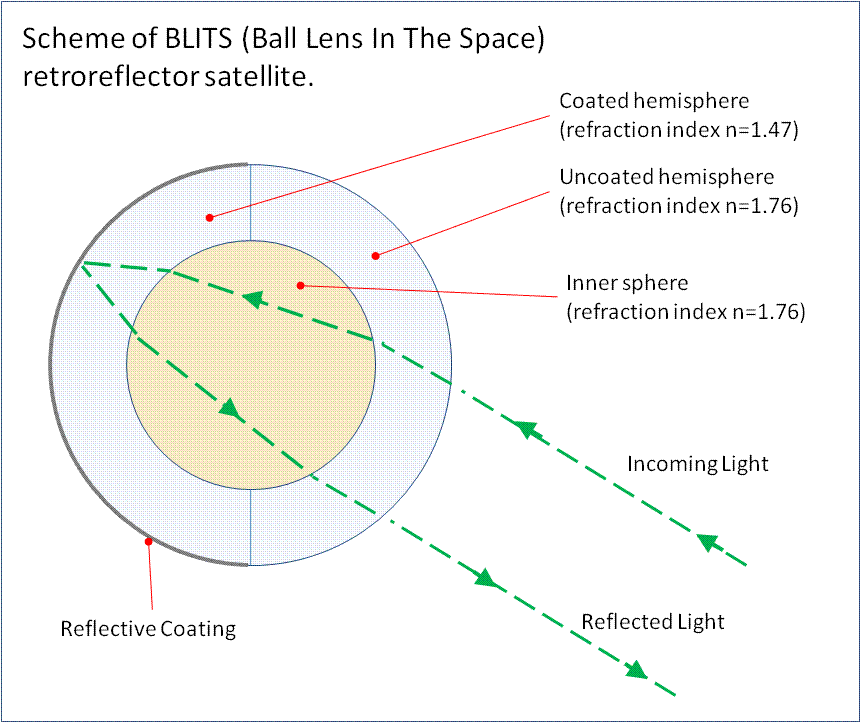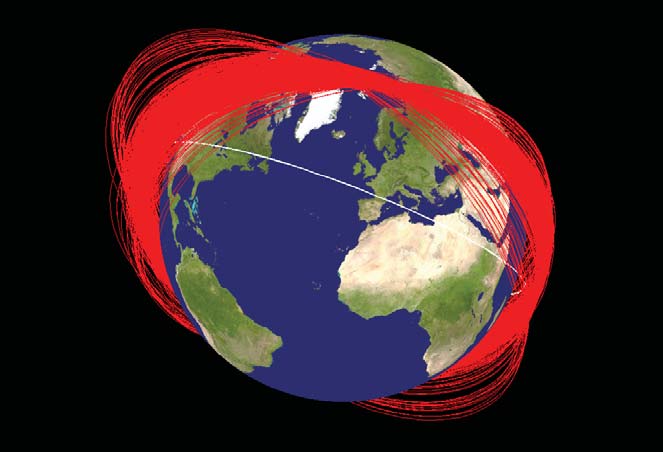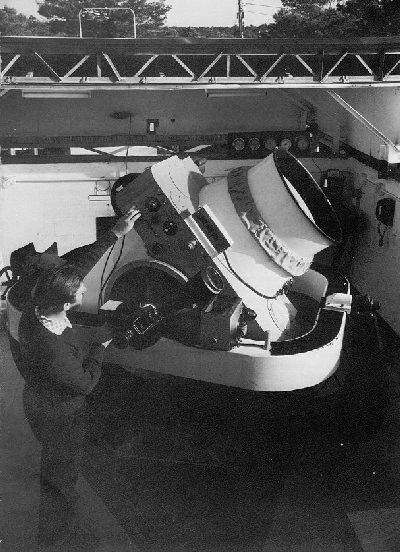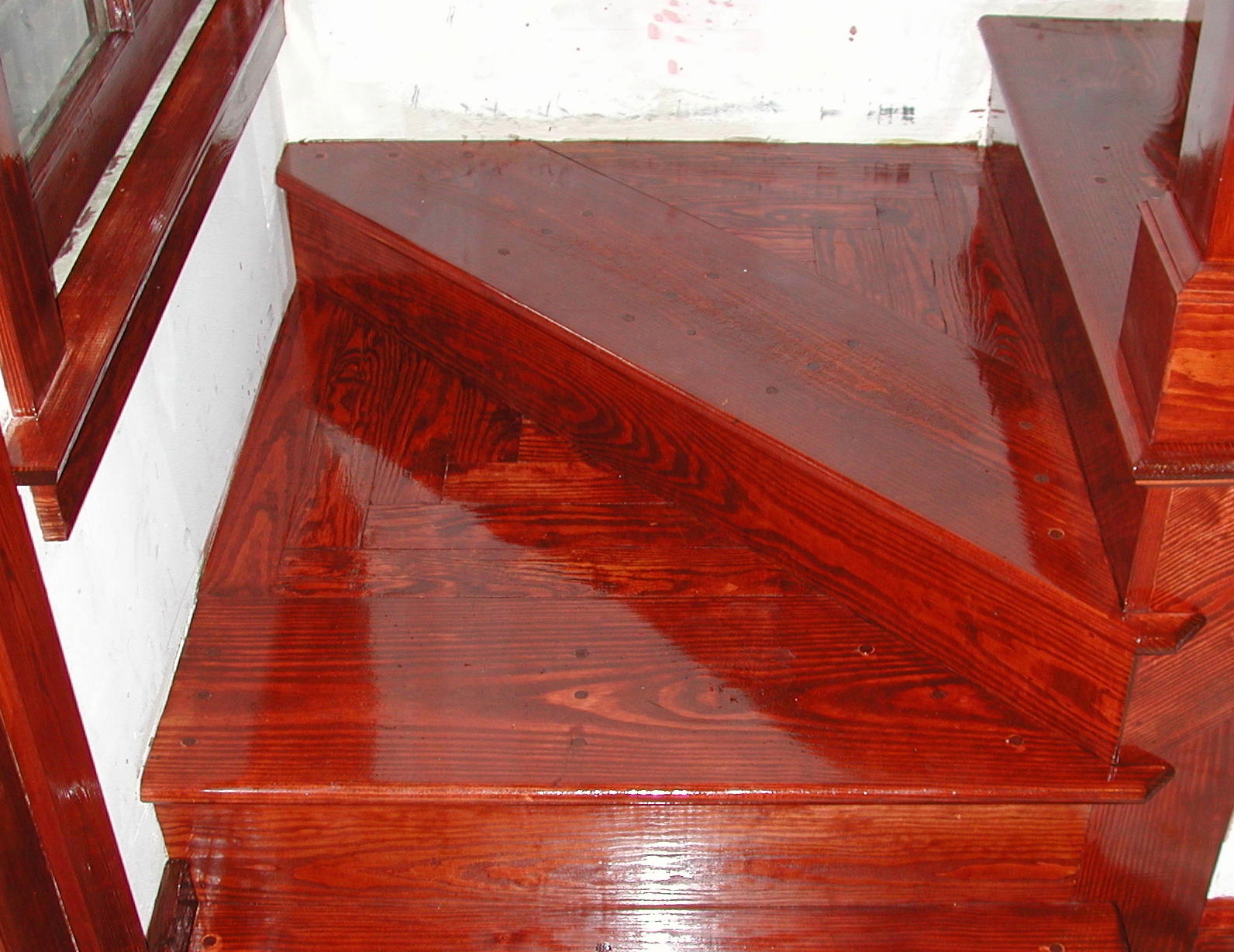|
Blits (other)
BLITS (Ball Lens In The Space) is a Russian satellite launched on September 17, 2009, as a secondary payload on a Soyuz-2.1b/Fregat, from the Baikonur Cosmodrome in Kazakhstan. The satellite is totally passive and spherical, and is tracked using satellite laser ranging (SLR) by the International Laser Ranging Service. The design of BLITS is based on the optical Luneburg lens concept. The retroreflector is a multilayer glass sphere; it provides uniform reflection characteristics when viewed within a very wide range of angles, and can provide a cross-section sufficient for observations at low to medium orbit heights. A similar design was already tested on a smaller laser reflector carried on board of the METEOR-3M spacecraft launched on December 10, 2001. The purpose of the mission was to validate the spherical glass retroreflector satellite concept and obtain SLR ( Satellite Laser Ranging) data for solution of scientific problems in geophysics, geodynamics, and relativity. ... [...More Info...] [...Related Items...] OR: [Wikipedia] [Google] [Baidu] |
Roskosmos
The State Space Corporation "Roscosmos" (russian: Государственная корпорация по космической деятельности «Роскосмос»), commonly known simply as Roscosmos (russian: Роскосмос), is a state corporation of the Russian Federation responsible for space flights, cosmonautics programs, and aerospace research. Originating from the Soviet space program founded in the 1950s, Roscosmos emerged following the dissolution of the Soviet Union in 1991. It initially began as the Russian Space Agency, which was established on 25 February 1992russian: Российское космическое агентство, ''Rossiyskoye kosmicheskoye agentstvo'', or RKA (russian: РКА). and restructured in 1999 and 2004, as the Russian Aviation and Space Agencyrussian: Российское авиационно-космическое агентство, ''Rossiyskoye aviatsionno-kosmicheskoye agentstvo'', commonly known as (rus ... [...More Info...] [...Related Items...] OR: [Wikipedia] [Google] [Baidu] |
Refraction
In physics, refraction is the redirection of a wave as it passes from one medium to another. The redirection can be caused by the wave's change in speed or by a change in the medium. Refraction of light is the most commonly observed phenomenon, but other waves such as sound waves and water waves also experience refraction. How much a wave is refracted is determined by the change in wave speed and the initial direction of wave propagation relative to the direction of change in speed. For light, refraction follows Snell's law, which states that, for a given pair of media, the ratio of the sines of the angle of incidence ''θ1'' and angle of refraction ''θ2'' is equal to the ratio of phase velocities (''v''1 / ''v''2) in the two media, or equivalently, to the refractive indices (''n''2 / ''n''1) of the two media. :\frac =\frac=\frac Optical prisms and lenses use refraction to redirect light, as does the human eye. The refractive index of materials varies with the wavelengt ... [...More Info...] [...Related Items...] OR: [Wikipedia] [Google] [Baidu] |
Spacecraft Launched In 2009
A spacecraft is a vehicle or machine designed to fly in outer space. A type of artificial satellite, spacecraft are used for a variety of purposes, including communications, Earth observation, meteorology, navigation, space colonization, Planetary science, planetary exploration, and Space transport, transportation of Human spaceflight, humans and cargo spacecraft, cargo. All spacecraft except single-stage-to-orbit vehicles cannot get into space on their own, and require a launch vehicle (carrier rocket). On a sub-orbital spaceflight, a space vehicle enters outer space, space and then returns to the surface without having gained sufficient energy or velocity to make a full Earth orbit. For orbital spaceflights, spacecraft enter closed orbits around the Earth or around other Astronomical object, celestial bodies. Spacecraft used for human spaceflight carry people on board as crew or passengers from start or on orbit (space stations) only, whereas those used for robotic space m ... [...More Info...] [...Related Items...] OR: [Wikipedia] [Google] [Baidu] |
Rokot
Rokot (russian: Рокот meaning ''Rumble'' or ''Boom''), also transliterated Rockot, was a Russian space launch vehicle that was capable of launching a payload of into a Earth orbit with 63° inclination. It was based on the UR-100N (SS-19 Stiletto) intercontinental ballistic missile (ICBM), supplied and operated by Khrunichev State Research and Production Space Center. The first launches started in the 1990s from Baikonur Cosmodrome out of a silo. Later commercial launches commenced from Plesetsk Cosmodrome using a launch ramp specially rebuilt from one for the Kosmos-3M launch vehicle. The cost of the launcher itself was about US$15 million in 1999; The contract with European Space Agency (ESA) for launching Swarm in September 2013 was worth €27.1 million (US$36 million). Specifications Rokot's total mass was 107 tonnes, its length 29 metres and its maximum diameter 2.5 metres. The liquid-fueled launch vehicle comprised three stages. The lower two were based on the S ... [...More Info...] [...Related Items...] OR: [Wikipedia] [Google] [Baidu] |
Gonets-M
Gonets (Russian Гонец, for ''Messenger'') is a Russian civilian low Earth orbit communications satellite system. It consists of a number of satellites, derived from Strela military communications satellites. The first two satellites, which were used to test and validate the system, were launched by a Tsyklon-3 launch vehicle from the Plesetsk Cosmodrome on 13 July 1992, and were designated Gonets-D. The first operational satellites, designated Gonets-D1, were launched on 19 February 1996. After launch, the first three satellites were given military Kosmos designations, a practice which was not continued with the other satellites. Ten operational satellites and two demonstration spacecraft have been placed in orbit. A further three were lost in a launch failure on 27 December 2000. A new series of modernised Gonets satellites, Gonets-D1M, supplement and replace the satellites which are currently in orbit. A single first D1M satellite was launched by a Kosmos-3M launch vehi ... [...More Info...] [...Related Items...] OR: [Wikipedia] [Google] [Baidu] |
BLITS Satellite Scheme
BLITS (Ball Lens In The Space) is a Russian satellite launched on September 17, 2009, as a secondary payload on a Soyuz-2.1b/Fregat, from the Baikonur Cosmodrome in Kazakhstan. The satellite is totally passive and spherical, and is tracked using satellite laser ranging (SLR) by the International Laser Ranging Service. The design of BLITS is based on the optical Luneburg lens concept. The retroreflector is a multilayer glass sphere; it provides uniform reflection characteristics when viewed within a very wide range of angles, and can provide a cross-section sufficient for observations at low to medium orbit heights. A similar design was already tested on a smaller laser reflector carried on board of the METEOR-3M spacecraft launched on December 10, 2001. The purpose of the mission was to validate the spherical glass retroreflector satellite concept and obtain SLR (Satellite Laser Ranging) data for solution of scientific problems in geophysics, geodynamics, and relativity. The ... [...More Info...] [...Related Items...] OR: [Wikipedia] [Google] [Baidu] |
2007 Chinese Anti-satellite Missile Test
On 11 January 2007, China conducted an anti-satellite missile test. A Chinese weather satellite—the FY-1C (COSPAR 1999-025A) polar orbit satellite of the Fengyun series, at an altitude of , with a mass of —was destroyed by a kinetic kill vehicle traveling with a speed of in the opposite direction (see ''Head-on engagement''). It was launched with a multistage solid-fuel missile from Xichang Satellite Launch Center or nearby. ''Aviation Week & Space Technology'' magazine first reported the test on 17 January 2007. The report was confirmed on 18 January 2007 by a United States National Security Council (NSC) spokesperson.BBC News (2007)Concern over China's missile test Retrieved January 20, 2007. The Chinese government did not publicly acknowledge that the test had occurred until 23 January 2007 when the Chinese Foreign Ministry issued a statement confirming the test. China claims it formally notified the U.S., Japan and other countries about the test in advance. It was the fi ... [...More Info...] [...Related Items...] OR: [Wikipedia] [Google] [Baidu] |
Collision
In physics, a collision is any event in which two or more bodies exert forces on each other in a relatively short time. Although the most common use of the word ''collision'' refers to incidents in which two or more objects collide with great force, the scientific use of the term implies nothing about the magnitude of the force. Some examples of physical interactions that scientists would consider collisions are the following: * When an insect lands on a plant's leaf, its legs are said to collide with the leaf. * When a cat strides across a lawn, each contact that its paws make with the ground is considered a collision, as well as each brush of its fur against a blade of grass. * When a boxer throws a punch, their fist is said to collide with the opponents body. * When an astronomical object merges with a black hole, they are considered to collide. Some colloquial uses of the word collision are the following: * A traffic collision involves at least one automobile. * A mid-air ... [...More Info...] [...Related Items...] OR: [Wikipedia] [Google] [Baidu] |
Fengyun-1C
On 11 January 2007, China conducted an anti-satellite missile test. A Chinese weather satellite—the FY-1C (COSPAR 1999-025A) polar orbit satellite of the Fengyun series, at an altitude of , with a mass of —was destroyed by a kinetic kill vehicle traveling with a speed of in the opposite direction (see ''Head-on engagement''). It was launched with a multistage solid-fuel missile from Xichang Satellite Launch Center or nearby. ''Aviation Week & Space Technology'' magazine first reported the test on 17 January 2007. The report was confirmed on 18 January 2007 by a United States National Security Council (NSC) spokesperson.BBC News (2007)Concern over China's missile test Retrieved January 20, 2007. The Chinese government did not publicly acknowledge that the test had occurred until 23 January 2007 when the Chinese Foreign Ministry issued a statement confirming the test. China claims it formally notified the U.S., Japan and other countries about the test in advance. It was the fi ... [...More Info...] [...Related Items...] OR: [Wikipedia] [Google] [Baidu] |
Space Surveillance Network
The United States Space Surveillance Network (SSN) detects, tracks, catalogs and identifies artificial objects orbiting Earth, e.g. active/inactive satellites, spent rocket bodies, or fragmentation debris. The system is the responsibility of United States Space Command and operated by the United States Space Force. Space surveillance accomplishes the following: * Predict when and where a decaying space object will re-enter the Earth's atmosphere; * Prevent a returning space object, which to radar looks like a missile, from triggering a false alarm in missile-attack warning sensors of the U.S. and other countries; * Chart the present position of space objects and plot their anticipated orbital paths; * Detect new artificial objects in space; * Correctly map objects traveling in Earth orbit; * Produce a running catalog of artificial space objects; * Determine ownership of a re-entering space object; * Inform NASA whether or not objects may interfere with the International Space S ... [...More Info...] [...Related Items...] OR: [Wikipedia] [Google] [Baidu] |
Varnish
Varnish is a clear transparent hard protective coating or film. It is not a stain. It usually has a yellowish shade from the manufacturing process and materials used, but it may also be pigmented as desired, and is sold commercially in various shades. Varnish is primarily used as a wood finish where, stained or not, the distinctive tones and grains in the wood are intended to be visible. Varnish finishes are naturally glossy, but satin/semi-gloss and flat sheens are available. History The word "varnish" comes from Mediaeval Latin ''vernix'', meaning odorous resin, itself derived from Middle Greek ''berōnikón'' or ''beroníkē'', meaning amber or amber-colored glass. A false etymology traces the word to the Greek ''Berenice'', the ancient name of modern Benghazi in Libya, where the first varnishes in the Mediterranean area were supposedly used and where resins from the trees of now-vanished forests were sold. Early varnishes were developed by mixing resin—pine sap, for ex ... [...More Info...] [...Related Items...] OR: [Wikipedia] [Google] [Baidu] |
Aluminum
Aluminium (aluminum in American and Canadian English) is a chemical element with the symbol Al and atomic number 13. Aluminium has a density lower than those of other common metals, at approximately one third that of steel. It has a great affinity towards oxygen, and forms a protective layer of oxide on the surface when exposed to air. Aluminium visually resembles silver, both in its color and in its great ability to reflect light. It is soft, non-magnetic and ductile. It has one stable isotope, 27Al; this isotope is very common, making aluminium the twelfth most common element in the Universe. The radioactivity of 26Al is used in radiodating. Chemically, aluminium is a post-transition metal in the boron group; as is common for the group, aluminium forms compounds primarily in the +3 oxidation state. The aluminium cation Al3+ is small and highly charged; as such, it is polarizing, and bonds aluminium forms tend towards covalency. The strong affinity towards ox ... [...More Info...] [...Related Items...] OR: [Wikipedia] [Google] [Baidu] |








